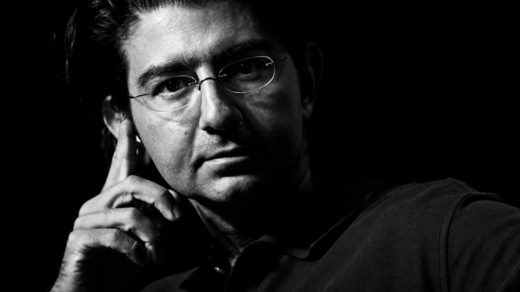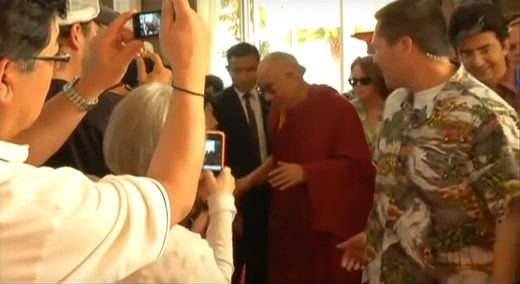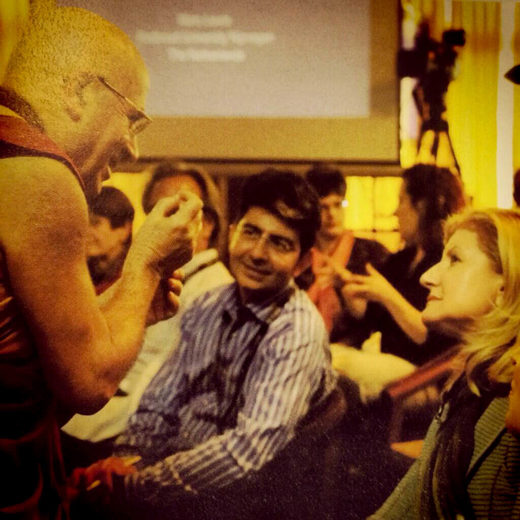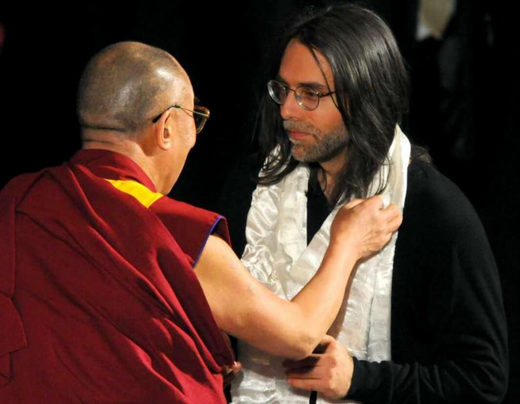Pierre Omidyar: A Billionaire Prone to Reclusiveness, And His Trove of State Surveillance Secrets
Alexander Rubinstein & Max Blumenthal
MintPress News
This is the concluding part of our series exploring billionaire eBay founder Pierre Omidyar’s broad sweep of influence over global media and surveillance enterprises. Part 1 examined Omidyar’s use of investment to build a vast and tangled web of influence in NGOs and media outlets around the world; Part 2 illuminated his involvement with regime-change networks and the surveillance state.
© Jb Reed | Bloomberg | Editing by MintPress News
eBay founder Pierre Omidyar speaks at the eBay Developer’s Conference in Boston, Massachusetts, Wednesday, June 13, 2007.
Flinging accusations of cultism while funding the Dalai Lama
Since pumping $100 million into a network of news outlets, fact-checking sites, film projects and press-advocacy groups, Pierre Omidyar has emerged as one of the most quietly influential media funders in the country. All along, he has kept out of the spotlight, avoiding the scrutiny and attack campaigns that have followed other politically influential oligarchs like Jeff Bezos and George Soros.
Omidyar lives in Honolulu, Hawaii, far from the American mainland. From there, he courts famous gurus and wields his media empire against a Hawaiian lawmaker who has emerged as the most outspoken opponent of the national security state and its militaristic agenda.
The billionaire’s target is Rep. Tulsi Gabbard (D-HI), a military veteran and member of Congress from Omidyar’s primary state of residence, Hawaii. Gabbard recently announced a long-shot campaign for the White House centered on mobilizing opposition to U.S. regime-change wars and interventionism.
Mark Ames, co-host of the Radio War Nerd podcast and former editor of The eXile, who produced a series of investigations on Omidyar’s media activities, described the billionaire’s attacks on Gabbard as “very particular to Hawaiian politics and Omidyar’s love for the military-intelligence world. If you chart their respective political trajectories,” Ames continued, “you’ll see that Tulsi [Gabbard] has learned from her past mistakes and moved left on major issues, while Omidyar has moved gradually to the right – which is where he was already aligned overseas.”
This December, The Intercept published an article entitled, “Tulsi Gabbard is a rising progressive star, despite her support for Hindu nationalists.” It was one in a long series of sharply critical pieces leveled at Gabbard by Omidyar-backed publications. Omidyar’s local Hawaiian outlet, the Honolulu Civil Beat, promptly re-published the article.
This article homed in on Gabbard’s relationship with American supporters of Narendra Modi, the prime minister of India and leader of a party, the BJP, that has stoked lethally violent attacks on Muslims in the past. The article based its case partly on the arguably bigoted assertion that Gabbard had many donors with “names that are of Hindu origin.” It noted only in passing that Gabbard had recused herself from attending the 2018 World Hindu Congress, a gathering that has been criticized as a global hub of Hindu nationalism. Three weeks after publishing the article, The Intercept published an apology for “a parenthetical sentence about donations to Tulsi Gabbard from individuals with names of Hindu origin, as identified by an expert.”
One local resident griped a few years ago about two articles published on the same day in Civil Beat in 2015 that tied Gabbard to Modi and the BJP, and another that profiled “rumors” of Gabbard’s involvement with a group it paints as an even more cultish offshoot of the Hare Krishna movement called the “Science of Identity Foundation.”
That Omidyar’s outlets publish so much material criticizing Gabbard on the basis of her connections to the BJP raises serious questions of hypocrisy. Jayant Sinha, a former member of Omidyar’s five-member global executive committee and managing director for the Omidyar Network’s India branch (whose shady financial practices were detailed in the Panama Papers), is a member of Modi’s cabinet and oversaw the effort to put Modi in power while heading the Omidyar Network in India. Sinha, in fact, used Omidyar’s funding to bankroll a series of anti-corruption campaigns through local NGOs that helped subvert the Indian public’s faith in the ruling center-left Congress Party. In July, Sinha honored eight men who were convicted of lynching a Muslim cattle trader by placing wreaths of marigolds over their heads after they were bailed out of prison.
And there is no shortage of irony in a paper owned by Omidyar wielding charges of participation in a cult against Gabbard. The billionaire is himself a devoted follower of the Tibetan spiritual leader Lhamo Thondup, better known as the Dalai Lama, who was previously the head of a relatively minor Buddhist sect until it was exploited by the CIA as a weapon against communist China.
Tibetan Buddhists seek a return to theocratic feudal rule in the plateau and believe the Dalai Lama is psychic, capable of divination, and the embodiment of the deity Avalokiteśvara, or the “lord who gazed down at the world.” The Dalai Lama himself says that he learned through his own psychic dreams that he would live to be 113 years old.
Christine Chandler, author of the book Enthralled: The Cult of Tibetan Buddhism, writes of her six-year-long experience in the sect:
“It was not until I managed to extricate myself from these lamas and their guru-worshipping influences, that I realized I had actually been in an authoritarian, thought-controlling cult, that disguises itself as representing the ‘highest teachings of the Buddha’… that uses the same techniques and engages in the same destructive behaviors found in the most dysfunctional of sexually abusive family systems: those that use religion to justify their abuse.”
In 1996, the Dalai Lama’s administration admitted to getting $1.7 million a year in funding from the CIA during the 1960s. More recently, he has participated in forums of the National Endowment for Democracy (NED), a U.S. government-funded NGO that promotes regime change across the globe through grants to opposition civil-society and media outfits.
“I love President Bush,” the Dalai Lama declared in 2002. The spiritual leader has also been an ardent defender of Israel, remarking that “the side of Palestine is dry and not green. They should use the skills of the Jews and live together.” The Dalai Lama has appeared at several of the Hindu World Congress conventions and effusively praised the Hindu nationalist grassroots movement known as the RSS.
Like the CIA before him, Omidyar has been a “generous” donor to Dalai Lama institutions, financing the Dalai Lama’s 2012 trip to Hawaii and other initiatives to promote the Tibetan spiritual leader.
Omidyar (upper right-hand corner) is seen with his personal security detail in 2012 escorting the Dalai Lama through Honolulu’s airport.
In 2011, the Omidyars gave more than $50,000 to the Tibet Fund, an NGO and the main conduit for cash flows from foreign donors and foreign governments to the privately-funded Central Tibetan Administration. This India-based quasi-government-in-exile is a largely astroturfed national-identity project, complete with an anthem, flag and various media organs that, according to author Lynn Pulman, claim that the Chinese government intends to “eradicate the Tibetan race.” The “administration” calls on the Tibetan diaspora to “maintain the greatness and vitality of Tibetan race and national culture.” USAID awarded it $23 million in 2016.
Omidyar’s fellow media mogul, Arianna Huffington – who launched a site in partnership with Omidyar’s other news venture, the Civil Beat – has also fallen under the influence of the Dalai Lama, as evidenced in part by her prolific pro-Dalai Lama tweets. She has also been photographed with the Dalai Lama’s gatekeeper in America, Lama Tenzin Dhonden, on multiple occasions.
Omidyar’s right hand at eBay, Jeffrey Skoll, honored the leader with the Global Treasure Award at the 2016 Skoll World Forum and gave a speechhailing “his Holiness” the Dalai Lama as “in heart and spirit a kindred soul to social entrepreneurs.”
The sex cult and slave plantation
Through their affiliation with the Dalai Lama, Omidyar and his wife Pam have reportedly fostered a relationship with Tibetan monk Tenzin Dhonden as well. The billionaire has junketed Tenzin around on his private jet, hosted him at his Hawaiian estate, and coordinated meetings together with the Dalai Lama.
Tenzin began his monastic training at the age of eight under the Dalai Lama. He has lived in the U.S. for the past 20 years, working as a fixer for the spiritual leader and connecting him with corporate media and Silicon Valley tycoons.
The Omidyars’ friendship with Tenzin appeared to end, however, when the monk was removed from his position as personal emissary for the Dalai Lama after he was exposed as having been involved with a U.S.-based elite sex slave cult called Nxivm (pronounced “Nexium”). That cult’s leader was an American huckster named Keith Raniere who convinced his cult followers that he possessed the ability to heal their ailments by having sex with them.
In 2009, Tenzin organized a secret deal for the Dalai Lama to endorse Raniere. Before an audience of 3,000 Nxivm followers, the Dalai Lama granted Raniere a Tibetan “scarf of purity.” The Dalai Lama was reportedly paid $1 million to appear at that event (he denied those reports). The Dalai Lama also wrote the foreword to the cult leader’s book around the same time. Tenzin, who had taken a vow of celibacy, was also accused of sleeping with one of the most prominent members of the Nxivm cult: Sara Bronfman, a Seagram’s heiress who has pumped her millions into Dalai Lama-related causes alongside Omidyar. In the fashion of a true new age guru, the Venerable Lama Tenzin Dhonden has also been photographed with his arm around Sara Bronfman’s mother and a look of delight on his face.
Raniere and his co-cult leader, former television actress Allison Mack, are currently awaiting trial over sex-trafficking, sexual conspiracy, and forced-labor charges. Both are accused of subjecting women in the cult to extreme sexual and physical abuse, including brandingthe initials “KM” and “AM” into the pelvic regions of their devoted followers, who were described by the New York Times as “sex slaves.”Both Raniere and Mack have pleaded not guilty to the charges.
© Andrew Mendonca | Facebook
The Dalai Lama awards jailed former sex cult leader Keith Raniere a Tibetan “scarf of purity.”
Nxivm reportedly held “wild parties” on Sir Richard Branson’s private island. Branson has not only joined with Omidyar in a public-relations initiative to promote themselves as “philanthropreneurs” and in funding Enterprise Zimbabwe; he has also conducted seminars with the Dalai Lama, whom he often describes as a spiritual inspiration.
Members of the Omidyar Network and Nxivm were both listed in 2007 as members of the Clinton Global Initiative. In 2009, Omidyar donated $30 million to the Clintons’ organization.
Omidyar may not have been a Nxivm member, but it can be argued that he was, at the very least, sex slave cult-adjacent. Shockingly, this was not the billionaire’s only instance of entanglement with accused slaveholders.
From a “modern-day slavery” scandal to glowing PR
In 2006, Omidyar and his wife Pam nested themselves in Honolulu and slowly began investing in local businesses. The following year, Omidyar pumped $10 million into the Maui Land and Pineapple Company (MLP), a self-described “landholding and operating company dedicated to agriculture, resort operation and the creation and management of holistic communities.”
In 2010, MLP would find itself connected to the largest human trafficking case in U.S. history, when its foreign-labor supplier was accused by the FBI of having subjected its Thai employees to “modern-day slavery.” According to Omidyar’s own Civil Beat, MLP’s labor recruiter Global Horizons kept “more than 600 Thai immigrants as indentured laborers on farms in Hawaii, Washington, New York and other states.” The New York Times reported that Global Horizons “exploit[ed] hundreds of farmworkers from Thailand by confiscating their passports, putting them into debt and threatening to deport them.”
“I was pleased to invest in a company that had such an important legacy here in Hawaii,” Omidyar said after the case was opened in 2010. Still, he did not claim total ignorance, claiming that he found out about the human trafficking only in 2008, one year after his $10 million investment into MLP.
In 2010, two years after Omidyar said he learned of the “allegations” of slavery against MLP, the billionaire expanded his relationship with the company, taking over its organic pineapple farming operations through his Ulupono investment firm. Ulupono would partner again with MLP to support research into the viability of locally produced biofuels in Hawaii.
While avoiding divesting from MLP, Omidyar relayed his “concerns” to the company’s CEO and “put [MLP] in touch with experts in the field of modern-day slavery and human trafficking – including Dr. Kevin Bales, the founder of Free the Slaves – in order to help the company create formal internal policies and procedures that would ensure this kind of thing never happened under their watch.”
Bales has been accused by investigative journalist Christian Parenti of “promoting himself on the basis that he has successfully reformed the chocolate industry and largely halted its use of child labor in West Africa. But no such thing has happened.”
“Worse yet,” Parenti continued, “Bales’ organization [Free the Slaves] defended the chocolate industry when the Department of Labor sought to list cocoa as a product tainted by slave and child labor.”
By the time a judge ordered Global Horizons and Maui Pineapple to pay $12.3 million in damages to 82 victims of poor working conditions and discrimination in 2014, Omidyar’s involvement in the scandal had been forgotten.
He and his wife, Pam, were busy basking in glowing publicity for dumping $115 million into what Forbes described in a puff piece as the billionaire’s “battle to end human trafficking.” Called Humanity United, the Omidyars’ new foundation emphasized neoliberal remedies like “entrepreneurship and money management training” for indentured Nepalese bricklayers. In 2012, President Barack Obama announced a White House partnership with Humanity United, pledging $6 million from co-sponsors such as Goldman Sachs, the Wall Street mega-bank that helped fuel America’s foreclosure crisis.
Despite Omidyar’s prolific philanthropic activities – or perhaps because of them – he has become an extreme recluse. When a spokeswoman for Omidyar asked what she should tell reporters about him, Omidyar reportedly replied, “I like my privacy.” This tendency appears to influence his critical attitude towards mass surveillance, but has also taken him into some highly unusual realms of virtual reality.
Virtual life as “lawful evil”
Omidyar’s obsession with privacy has led him to embrace a form of survivalism that combines the paranoia of Doomsday Preppers with the social proclivities of a video game-addicted preteen. Not only has the billionaire hoarded “stockpiles” of emergency food near his home in Hawaii, purchased a solar-powered “safe house” in Montana, and hired a personal security detail of former Secret Service and State Department security officers, he’s also, as New York Magazine described it, “immersed himself” in a virtual-reality computer game called Second Life.
Second Life is sort of like “The Sims” for people with a thirst for escapism. The online game is not merely a game: it’s an outright “virtual world” designed to give players the ability to become their best selves, experiencing happiness and freedom unattainable in their actual lives.
Omidyar invested nearly $350,000 in the game’s developer during the mid-2000s, hailing its “revolutionary form of shared experience.”
And Omidyar would know, considering he’s created his own “Second Life” alter-ego, illustrated by New York Magazine. Kitto Mandala – a tattooed black man who could be spotted cruising on a Segway through corporate parking lots, wearing a shirt displaying the catchphrase “Kiss, me, I’m lawful evil” – offers a rare window into the psyche of one of the richest, and most enigmatic, men in the world. Perhaps it should be comforting to everyday plebeians that even a man worth an estimated $11.6 billion in this reality shares in the desire to escape it through a virtual personality. As is said, money isn’t everything.
Screenshots of Mandala posted on Flickr show the avatar in what appears to be a sex dungeon. Bound and strung from the ceiling in a compromised position, Mandala wears a shirt that reads “chaotic evil.”
“There is no manufactured conflict, no set objective,” in Second Life, according to the site’s developer, Linden Lab.
“Pierre has been such a reclusive guy for the past few years,” Linden’s founder Philip Rosedale remarked to NY Mag. So reclusive in fact, even some of his business partners are left to connect mainly with his better self, Kitto Mandala. Bizarrely, NY Magazine reports, “even after Omidyar became a Linden Lab investor, Rosedale primarily interacted with his animated avatar.”
Omidyar’s obsession with privacy seemed to feed his interest in opposing mass surveillance. He had also been seeking out a cause to burnish his image as an “anti-establishment” entrepreneur. In 2013, when Omidyar lost a bid for the Washington Post to rival Silicon Valley data monarch Jeff Bezos, he was presented with a prime opportunity to propel his interests.
Too little, too late: the perils of privatizing the Snowden documents
That year, Omidyar gave birth to The Intercept, recruiting anti-establishment journalists Jeremy Scahill, Glenn Greenwald, and Laura Poitras “to found a new media organization dedicated to the kind of reporting [the Snowden] disclosures required: fearless, adversarial journalism,” according to the news outlet’s website.
The Intercept promised to deliver a much-needed antidote to the progressive media sites that had blunted their criticisms of government policy during the Obama years – a venture promising to blend the rebelliousness of WikiLeaks with the professionalism of the New York Times.
Yet a noticeable difference between the WikiLeaks and Intercept models was immediately apparent: the newest transparency initiative had no plans to allow public access to the Snowden files, as WikiLeaks had done with the documents it acquired. The Intercept’s Greenwald pledged in 2014 to build a secure “reading room” where outside journalists could review files at the publication’s New York City office. That room has not materialized.
The Intercept Editor in Chief Betsy Reed did not respond to questions from MintPress about plans for the reading room or the possibility of allowing public access to the Snowden files.
Journalist Mark Ames was among only a handful who warned of the danger of a reclusive tech billionaire privatizing the state secrets gathered by Snowden. Ames also accused The Intercept’s founders of whitewashing Omidyar’s record, willfully ignoring his well-established history of political advocacy and soft-power partnerships.
Over four years later, The Intercept has published just a tiny fraction of the Snowden files. And some, including an explosive cable on the proxy war in Syria, were released years after they might have made an impact.
In October 2017, The Intercept chose to publish a cable from the trove of NSA documents gathered by Snowden that revealed Saudi Prince Salman bin Sultan explicitly directing a faction of Syrian insurgents to “light up” Damascus and “flatten” its civilian airport on March 18, 2013. The cable also revealed that Saudi Arabia had supplied 120 tons of explosives to the armed opposition, resulting in attacks on the Syrian presidential palace and locations across Damascus. It noted that Saudi leadership was “very pleased” with the campaign of terror they had orchestrated through their proxies.
As MintPress previously noted, that cable had been in the possession of The Intercept’s founders for over four years, but it was inexplicably held. Had it been released soon after The Intercept leadership acquired it, it would have revealed that the so-called “moderate rebels” were, in fact, waging a campaign of terror on behalf of foreign sponsors – and at a time when the U.S. was stepping up covert support to them. Yet The Intercept inexplicably waited until the Syrian conflict had reached its denouement, and handed the cable to Murtaza Hussain, a staff writer who has vehemently advocated for regime change for years.
This year, The Intercept has continued to roll out reporting based on Snowden documents years after they came into the outlet’s possession. In one March 2018 article, The Intercept declared that “the conspiracy theorists” were vindicated in their belief that the government was spying on Bitcoin users, as documents provided by Snowden and dated to March 2013 “show that the [NSA] indeed worked urgently to target bitcoin users around the world.”
Perhaps if those “conspiracy theorists” had been vindicated a few years sooner, they would not have been branded conspiracists at all.
In January The Intercept revealed another years-old Snowden document, framing its dubious contents in a way that furthered Washington’s emerging Cold War with China.
Authored by Micah Lee and Henrik Molte, the article bolstered claims that China had successfully deployed so-called “supply chain attacks” on the “servers belonging to over 30 American companies, including Apple, Amazon, and various government suppliers.”
It opened with a critique of a recent Bloomberg report that alleged that the Chinese army had implanted microchips into computer motherboards for sale in the U.S., blasting it for relying primarily on anonymous sources. Yet The Intercept ultimately echoed Bloomberg, contending that while the “story may well be completely (or partly) wrong, the danger of China compromising hardware supply chains is very real.” The authors supported their claim by citing a Snowden file that asserts “U.S. spy agencies were warned” of China’s power to spy through computer hardware nearly a decade ago.
Apparently, not all Snowden leaks are created equal. While some have exposed the totalitarian designs of the U.S. intelligence apparatus, others are being used to further its agenda by homing in on national adversaries like China. Today, all of these files remain in the hands of a single publication owned by a billionaire with a clear affinity for the national security state.
The arrangement highlights the sheer brilliance of Omidyar’s influence model. With strategically placed donations, he has placed himself in the rare position of being able to support both the national security state and at least part of its self-proclaimed opposition. In the eyes of the former element, that might be precisely what makes him so valuable.







